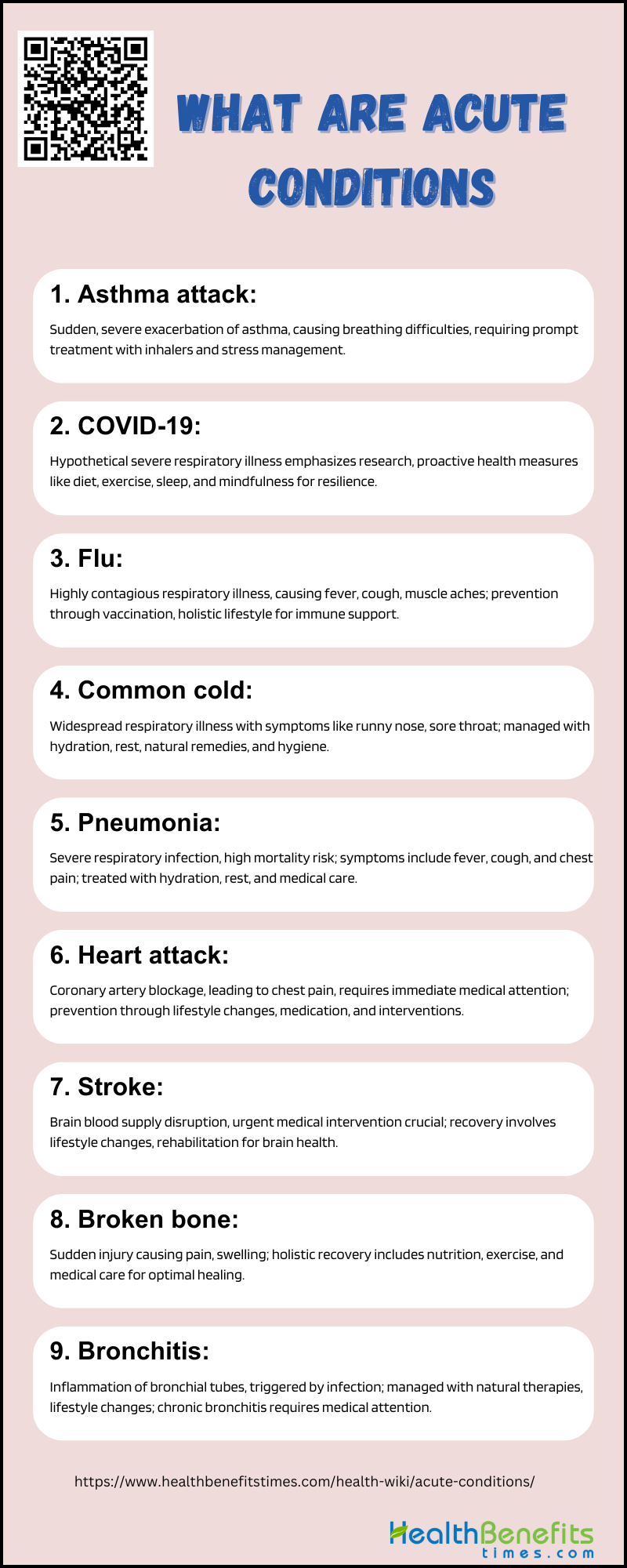Acute conditions are sudden and severe health issues that necessitate immediate attention, including infections, injuries, heart attacks, and dental emergencies. They are distinguished from chronic illnesses by their rapid onset and brief duration. It is crucial to recognize that individuals of any age or health status can be impacted by these conditions on a holistic health, fitness, and wellness website. Identifying early warning signs and promptly seeking medical care are essential for preventing complications and aiding the body’s recovery. Understanding acute conditions is vital for promoting a balanced lifestyle and ensuring well-being in our fast-paced society.
Causes of Acute Conditions
Acute conditions, which can manifest suddenly and require immediate medical attention, range from minor ailments like sore throats, which may indicate pharyngitis or laryngitis, to more serious issues like acute limb ischemia, where prompt action is needed to preserve limb function. These health issues can arise from various sources, including:
- Common cold
- Influenza, or pneumonia
- Allergens or pollutants
- Physical injuries
- Weak immune system
Examples of Acute Conditions (DND)
When sudden health issues occur, it is important to identify them as acute conditions. These conditions manifest suddenly, often with severe symptoms, and usually resolve quickly. From minor illnesses like the common cold to more serious events such as heart attacks, recognizing these conditions is essential for receiving prompt and proper medical attention. Let us now explore some specific examples of acute conditions that individuals may experience.
1. Asthma attack (the condition itself is chronic)
An asthma attack is a sudden and severe worsening of the chronic respiratory condition known as asthma, which can be frightening and life-threatening if not promptly addressed. During an attack, inflammation and constriction of the airways, muscle tightening, and increased mucus production lead to significant breathing difficulties, wheezing, coughing, and chest tightness. Immediate medical intervention is often necessary, including the use of quick-relief inhalers to reduce airway constriction, as well as holistic approaches like stress management and avoidance of triggers to promote overall health. It is crucial for individuals with asthma to have a good understanding of their condition, identify triggers like allergens or smoke, and adhere to a well-developed action plan that includes prescribed treatments in order to effectively manage their asthma and prevent severe attacks.
2. COVID-19
In the face of acute respiratory illnesses such as COVID-19 and the hypothetical COVID-29, research, including machine learning studies, has emphasized the importance of understanding preclinical characteristics and severity factors to improve surveillance and diagnostic management. These conditions can progress rapidly, causing symptoms such as high fever, cough, and shortness of breath, which can lead to severe respiratory distress requiring immediate medical intervention. Promoting a proactive approach to health, our comprehensive health, fitness, and wellness platform advocates for strengthening the immune system through a balanced diet, regular exercise, adequate sleep, and stress-reducing mindfulness practices. It is also crucial to stay informed about health advisories from reputable sources. By adopting such a holistic lifestyle, individuals can better withstand and recover from acute health threats, highlighting the necessity for ongoing research and preparedness for potential future viral challenges.
3. Flu
Influenza, commonly known as the flu, is a highly contagious respiratory illness that can have serious consequences if not properly treated. This illness is characterized by symptoms such as high fever, cough, and muscle aches, and can affect individuals of all ages, particularly those in at-risk groups such as the elderly, young children, and individuals with weakened immune systems. It is important to seek reliable information to know when urgent care is necessary. Holistic health practices emphasize the importance of prevention, promoting a strong immune system through a healthy diet, regular exercise, adequate sleep, and natural remedies. Vaccinations are also a crucial preventive measure, aligning with the holistic approach to proactive wellness in reducing the impact of the flu on overall health.
4. Common cold
According to article, the common cold, a widespread respiratory illness caused by rhinoviruses, affects numerous individuals regardless of location or demographic. Symptoms such as a runny or congested nose, sore throat, coughing, sneezing, and fatigue are common and can persist for a few days to two weeks. While there is no cure, holistic health practices recommend supporting the body’s natural healing process through adequate hydration, rest, and nutrition from whole foods. Natural remedies such as herbal teas, steam inhalation, essential oils, honey, and zinc can also offer relief. Preventative measures include practicing good hygiene, such as frequent hand washing and avoiding close contact with infected individuals. Maintaining a strong immune system through a balanced lifestyle that includes regular exercise, stress management, and sufficient sleep is crucial for overall health and resilience against such infections.
5. Pneumonia
Pneumonia is a severe acute respiratory infection that poses a significant risk to young children, the elderly, and individuals with weakened immune systems. It is highly prevalent in developing countries, where it can result in high mortality rates. This condition causes inflammation in the lungs, often as a result of bacterial, viral, or fungal infections, and is characterized by symptoms such as fever, cough, difficulty breathing, and chest pain, all of which necessitate immediate medical attention. Holistic health practices recommend a balanced diet, adequate hydration, and rest, as well as deep breathing exercises, herbal remedies, and essential oils to alleviate symptoms and enhance respiratory health during recovery. Preventative measures such as vaccinations and proper hygiene are crucial, along with maintaining a strong immune system through good nutrition, regular physical activity, and sufficient sleep, in order to prevent and recover from pneumonia effectively.
6. Heart attack
A heart attack, also known as an acute myocardial infarction, is a serious medical event caused by a blockage in a coronary artery that restricts blood flow and oxygen to the heart muscle. This blockage is often a result of coronary artery disease related to atherosclerosis. Symptoms such as chest pain, difficulty breathing, and nausea indicate the need for immediate medical attention to prevent severe heart damage or death. Lifestyle factors such as smoking, poor diet, and lack of physical activity significantly increase the risk of experiencing a heart attack. It is important to focus on preventive measures such as maintaining a balanced diet, engaging in regular exercise, reducing stress, and avoiding tobacco and excessive alcohol consumption to promote heart health and reduce the likelihood of such emergencies. With prompt medical intervention, including medications and procedures like angioplasty, patients can recover from a heart attack, underscoring the importance of early detection and a proactive approach to cardiovascular well-being.
7. Stroke
Stroke is a serious medical emergency that poses a particular threat to individuals with diabetes mellitus due to the similarity in symptoms to diabetic ketoacidosis, which can make prompt and accurate diagnosis difficult. It occurs when the brain’s blood supply is compromised, leading to the rapid death of brain cells, potentially resulting in irreversible damage, disability, or death. Recognizing stroke symptoms quickly, such as sudden numbness, confusion, speech difficulties, vision problems, dizziness, or loss of coordination, is crucial for immediate medical intervention, which can greatly improve recovery prospects. It is important to emphasize the swift recognition of these signs on a comprehensive health website, as well as promote a heart-healthy lifestyle to reduce the risk of stroke. Recovery strategies often involve dietary changes, physical therapy, and stress reduction to support brain health and rehabilitation.
8. Broken bone
A fracture, also known as a broken bone, is a sudden injury that can occur in any part of the body, often as a result of excessive force or accidents, causing symptoms like pain, swelling, and sometimes deformity. Holistic health emphasizes a comprehensive recovery plan that goes beyond just immobilization and pain management. This includes a balanced diet with essential nutrients for bone repair, such as calcium and vitamin D, as well as gentle exercises and mind-body practices to maintain muscle strength and overall well-being during the healing process. Furthermore, advancements in medical technology, such as bone setting plates and specialized filling materials, have enhanced the healing of fractures and the prevention of further injury. It is essential to collaborate with healthcare professionals to develop a personalized plan that addresses the physical, emotional, and nutritional needs for optimal recovery.
9. Bronchitis
Bronchitis is a common respiratory condition characterized by inflammation of the bronchial tubes, often triggered by a cold or other respiratory infection. Symptoms include a persistent cough, sometimes with mucus, wheezing, and chest tightness, typically lasting around three weeks. Although acute bronchitis usually resolves on its own, it can have a significant impact on one’s health, highlighting the importance of effective management. A holistic health approach, focusing on natural therapies to support the immune system and lung health, including dietary choices, herbal remedies, and lifestyle changes, is recommended. Gentle exercises, steam inhalation, and avoiding irritants such as tobacco smoke can aid in recovery. Chronic bronchitis, a more severe form often associated with smoking, requires medical intervention.
How to Identify an Acute Condition?
Acute conditions, such as the flu, asthma attacks, or a broken bone, manifest suddenly with severe symptoms such as sharp pain, fever, or swelling, and typically resolve within six months. Recognizing these symptoms promptly is crucial, as they can escalate rapidly and may indicate more serious health issues requiring immediate attention. In holistic health, it is also important to consider how environmental and emotional factors may impact these acute presentations. For accurate diagnosis, particularly in cardiovascular events, clinicians may utilize focused echocardiography to identify signs such as acute right ventricular strain, which is crucial in managing conditions like pulmonary embolism. Timely medical assessment combined with supportive holistic therapies can greatly enhance recovery and overall well-being, addressing both the physical and broader health aspects of the individual.
Difference between Acute and Chronic Conditions
In the field of holistic health and wellness, it is important to distinguish between acute and chronic conditions, as they each have unique effects on health. Acute conditions, such as injuries, infections, or sudden illnesses like influenza, have a rapid onset and short duration. They often have severe symptoms but can usually be resolved with prompt treatment over a few days to weeks. Chronic conditions, such as diabetes, heart disease, and arthritis, develop slowly and can last for months to years, requiring ongoing management and lifestyle changes due to their often incurable nature. These long-term conditions can impact multiple body systems and require continuous care to maintain health and manage symptoms. Understanding the differences between acute and chronic conditions is crucial for individuals to pursue appropriate health strategies and treatments, ensuring a comprehensive approach to their overall well-being.


